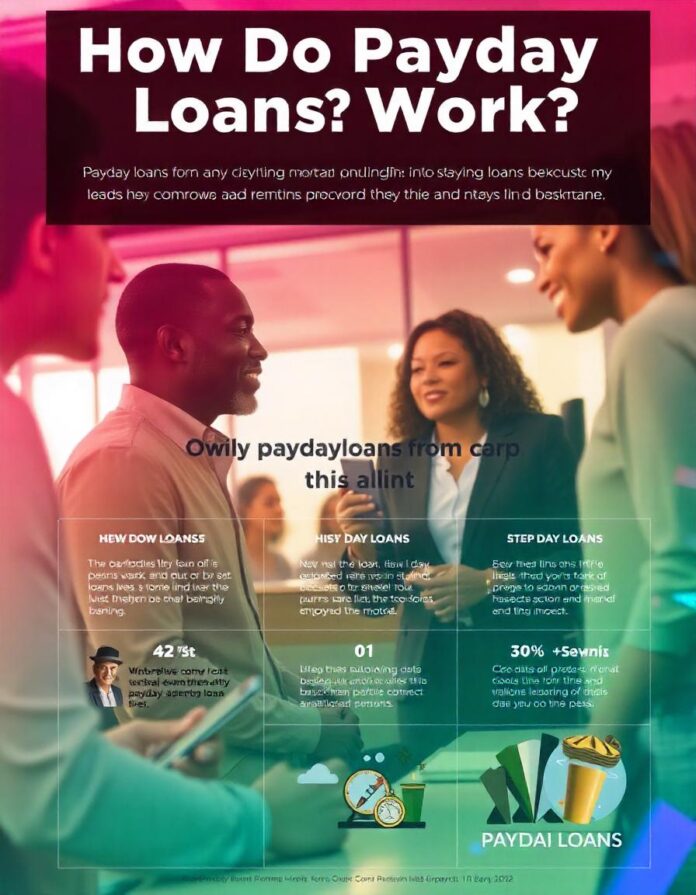it’s essential to understand how payday loans work, their benefits, risks, and alternatives. Payday loans are a controversial yet common financial product designed for people in need of quick cash. If you’ve ever faced an emergency like a surprise car repair, medical bill, or overdue utility payment, you might have considered a payday loan as a solution. But before diving in, it’s important to understand how payday loans work, the pros and cons, and the result thereafter.
In this blog, we’ll break down the mechanics of payday loans, share real-life stories, and provide actionable advice to help you make informed decisions.
What Are Payday Loans?
Payday loans are short-term loans intended to help borrowers cover unexpected expenses. These loans are typically repaid in full on your next payday, hence the name.
Key Features of Payday Loans
- Loan Amounts: Usually between $100 and $1,000, depending on state laws and income.
- Interest Rates: Extremely high, often exceeding 300% APR.
- Repayment Terms: Typically 2–4 weeks.
- Approval Requirements: Proof of income, a bank account, and valid ID; no credit check required.
Storytime: Mark’s Payday Loan Journey
Mark, a 33-year-old delivery driver, needed $500 to fix his car. Without it, he couldn’t work and earn his next paycheck. He applied for a payday loan at a local lender, got approved within minutes, and walked out with $500 cash.
Two weeks later, Mark owed $575—the $500 loan plus a $75 fee. When payday came, Mark realized he couldn’t afford to repay the full amount. The lender offered to “roll over” the loan, tacking on another $75 fee. By the end of three months, Mark had paid $300 in fees and still owed the original $500.
How Payday Loans Work
- Application Process
Most payday loans require minimal documentation: proof of income, a bank account, and identification. Some lenders operate online, while others have physical storefronts. - Approval
Approval is usually quick, often within minutes, as lenders do not perform credit checks. - Loan Terms
You’ll agree to repay the loan in full, including fees, on your next payday. Repayment is often done through a post-dated check or automatic bank withdrawal. - Repayment
If you cannot repay the loan on time, the lender may allow you to roll it over, adding additional fees.
The True Cost of Payday Loans
Payday loans may seem simple, but their costs can spiral out of control.
Example:
- Loan Amount: $500
- Fee: $15 per $100 borrowed = $75
- Total Repayment: $575 in two weeks
- APR: 391%
If you roll over the loan three times, you’ll pay $300 in fees alone, not including the original loan amount.
Infographic Idea: Payday Loans at a Glance
Title: “The Cost of Borrowing $500”
| Scenario | Fees Paid | Total Owed | APR |
|---|---|---|---|
| Initial Loan | $75 | $575 | 391% |
| 1 Rollover | $150 | $650 | 391% |
| 3 Rollovers | $300 | $800 | 391% |
The Benefits of Payday Loans
- Quick Access to Cash
Payday loans are often disbursed within hours, making them ideal for urgent situations. - No Credit Check
These loans are accessible to people with poor or no credit. - Simple Requirements
Approval requires minimal paperwork compared to traditional loans.
The Risks of Payday Loans
- Exorbitant Interest Rates
Payday loans are one of the most expensive borrowing options. - Debt Cycle Risk
Short repayment terms and high fees often lead to rollovers, trapping borrowers in a cycle of debt. - No Credit Building
Payday lenders do not report repayments to credit bureaus, so timely repayment won’t improve your credit score. - Aggressive Collection Practices
Failure to repay can lead to overdraft fees, collection calls, and even legal action. Learn more about payday loan risks at CFPB.
Alternatives to Payday Loans
1. Credit Union Loans
Credit unions offer small-dollar loans with much lower interest rates.
2. Employer Advances
Many companies allow paycheck advances without interest or fees.
3. Personal Loans
Banks and online lenders offer personal loans with lower APRs and flexible repayment terms. Compare personal loans on NerdWallet.
4. High-Yield Savings Accounts
Building an emergency fund is the best long-term solution. Learn how to Build an Emergency Fund on a Tight Budget.
How to Borrow Responsibly
If a payday loan is your only option, here are some tips to minimize risks:
- Borrow Only What You Need
Avoid borrowing more than necessary to cover your emergency. - Understand the Terms
Read the fine print to know the total repayment amount, fees, and penalties. - Have a Repayment Plan
Budget carefully to ensure you can repay the loan without rolling it over. - Avoid Rollovers
Each rollover adds fees, increasing your total cost.
Reflection Questions
- Have you ever taken out a payday loan? What was your experience?
- Are there better alternatives available to meet your financial needs?
- How can you prepare for emergencies to avoid needing payday loans in the future?
Conclusion: Know Before You Borrow
Payday loans may offer quick cash, but their high costs and risks make them a last resort. Understanding how they work, exploring alternatives, and borrowing responsibly can help you avoid debt traps and make better financial choices.
Have you or someone you know used a payday loan? Share your experiences and tips in the comments below. Don’t forget to share this guide with others who might find it helpful!


